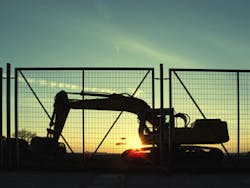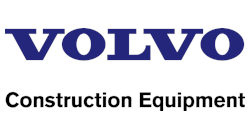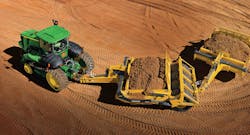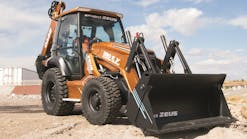Temporary Decisions
Several manufacturers remind us that the best solution for a particular project may be rental of an excavator. If the project is something that does not occur regularly in your work schedule, renting the exact size excavator could be a perfect answer. At the Wacker Neuson Group, founded in 1848, annual sales of more than a billion dollars, and 4,000 people employed worldwide, they have noticed a definite difference between the requirements of rental companies and actual end users. “End customers are usually more specific in their requirements and know exactly what they want regarding the operating weight, specific options, and main applications,” notes Silke Müller for Wacker Neuson. “This can be explained easily by some definite values that they must consider. These customers own a certain trailer or truck that can transport an exact weight that the new excavator may not exceed. They have specific applications in mind and already know whether they will need a zero tail model for use in confined spaces, or a regular configuration excavator. Also, they want their operators to be happy and may choose according to their preferences with regard to a particular brand or equipment. Rental companies have certain requirements and specifications in mind, too. Smaller rental companies may also attach greater importance to the price or short-term availability of the machine.”
A feature that can also make a difference for the purchaser is something like Wacker Neuson’s Vertical Digging System (VDS) for compact excavators. “The superstructure tilt levels height differences on uneven ground at the press of a button and thus ensures more productivity and efficiency because it saves 25% of material and time when removing and filling surfaces,” explains Müller. “At the same time, the VDS gives great stability and the work does not tire the operator as much thanks to the upright seating position. Such added advantages in efficiency, safety, and operator comfort can make a difference when considering which model of excavator to acquire.”
“Your project’s scope of work will help determine the size excavator needed,” advises Shane Sirmons, business development manager, Hyundai Construction Equipment Americas Inc. “For example, is your job a utility, site prep, demolition, or landscaping project, and what tasks do you expect the excavator to perform on those projects? For a utility project that requires a trenching task, you’ll need to look at new factors such as trench width and depth, as you’ll need to place the pipe and possibly a trench box with the excavator. Such items will decide the size, lift capacity, and dig depth of the excavator. Similar factors will also determine if you need a specialized bucket like a trench bucket/pipe bucket, depending on the width of the trench needed. Site prep tasks can vary from removing brush, logs, and stumps to larger excavations for removing overburden, bench cutting, and foundation excavation. For smaller site prep projects you should consider the Hyundai 15- to 35-metric-ton excavators. Larger excavations call for larger excavators in the 40- to 80-metric-ton range. It’s also a good idea to check the site conditions from soil type to how wet the land is, as this will determine if any specialized attachments are needed.”
Excavators can be fitted with a range of demolition attachments such as thumbs, grapples, hydraulic hammers, and shears. Some manufacturers also offer specialized demolition excavators with longer reach arms, heavier counterweights, and tilted cabs. “If you plan to add an attachment to your excavator, be sure to look over your excavator manual and speak with your dealer to ensure the excavator is capable of using that attachment,” advises Sirmons of Hyundai. “You want to make sure that the machine will provide enough power to operate the attachment, and if there are retrofits needed. Performing these basic steps will reduce unexpected downtime.”
Time for Homework
Volvo’s claim for its excavators is: “We have the right machine for your job.” And the company certainly has an impressive range of excavators from which customers can choose. In the range of larger models (with operating weights over 46,000 pounds) you can start at the EC220D, with its net horsepower of 172 and bucket capacity from 0.68 to 2.75 cubic yards, and travel through another 10 models until you reach the Volvo EC700C, with an operating weight over 152,000 pounds, 424 horsepower, and a bucket capacity from 3.17 to 8.63 cubic yards. Large excavators, indeed!
Top manufacturers like Volvo offer as much information as you need about your next excavator. This is when you must decide that a few hours of diligent homework by you could save thousands of dollars over a year’s projects. If you go to your local dealer and ask simply which is the best excavator for you, you know he will tell you one that he is trying to sell. It’s more complicated than that, and manufacturers like Volvo, Caterpillar, Doosan, Hyundai, Komatsu, Case, and John Deere will readily provide you with all the materials you need to make a wise decision. Your local dealer can also get that information and help you from his knowledge of the results other customers have enjoyed.
“With so many different sizes, types, and features available, you might think it impossible to choose find the one, perfect excavator,” advises Matthew Hendry, product consultant for hydraulic excavators with John Deere Construction & Forestry. “But it is possible to find a single excavator that does most, if not all of your required jobs. It just depends on your application needs. If the excavator is going to be used for a specific type of work, it is possible to build and buy the perfect excavator. In some applications, an excavator will do essentially the same job for its entire life. For contractors who do a variety of jobs, from demolition, loading trucks, digging basements and doing underground work, finding the “perfect” excavator may not be possible. But you can find one that will get pretty close.”
“An excavating contractor would typically look for a machine that will do 80% of his jobs,” says Hendry. “The 21-metric-ton class is the most popular answer. But the key is to configure it to be as versatile as possible. On the John Deere 210G, the contractor will want features and attachments like 28-inch triple grouser track pads, reversing fan, pattern changer, a 9-foot, 7-inch arm, hydraulic quick-coupler, auxiliary hydraulic kit, and a hydraulic thumb. The contractor will also want multiple buckets: 36-inch, 42-inch, and 48-inch digging buckets, a 60-inch ditch/cleanup bucket, as well as, perhaps, a hydraulic hammer and a grapple rake. For a contractor who does a variety of jobs, this machine configuration will work very well. The 21-metric-ton class is a good, versatile machine. But if your applications include production digging or setting heavy pipes, you might need a 38- to 47-metric-ton machine. Conversely, if you do some utility work or need to get into tight paces, a compact excavator would be required. The key is to choose the size class machine that will do the majority of your work and equip it to maximize its value to your operation.”
All these wise and practical tips and advice from experts at manufacturers only reinforce the idea that the customer has the greatest responsibility when it comes to buying or renting an excavator. That means you. You must decide what you want the excavator to accomplish. You must look at your future business and see the size and flexibility of the excavator that will serve you best. It doesn’t matter what is the smartest or biggest one available, it’s the one that will make your job the best and most profitable. It will take some homework, but the time spent on making a wise decision may well be the highest paid hours you work this year.








